Northwest Tribal Food Sovereignty Coalition gathering promotes traditional food practices & preservation
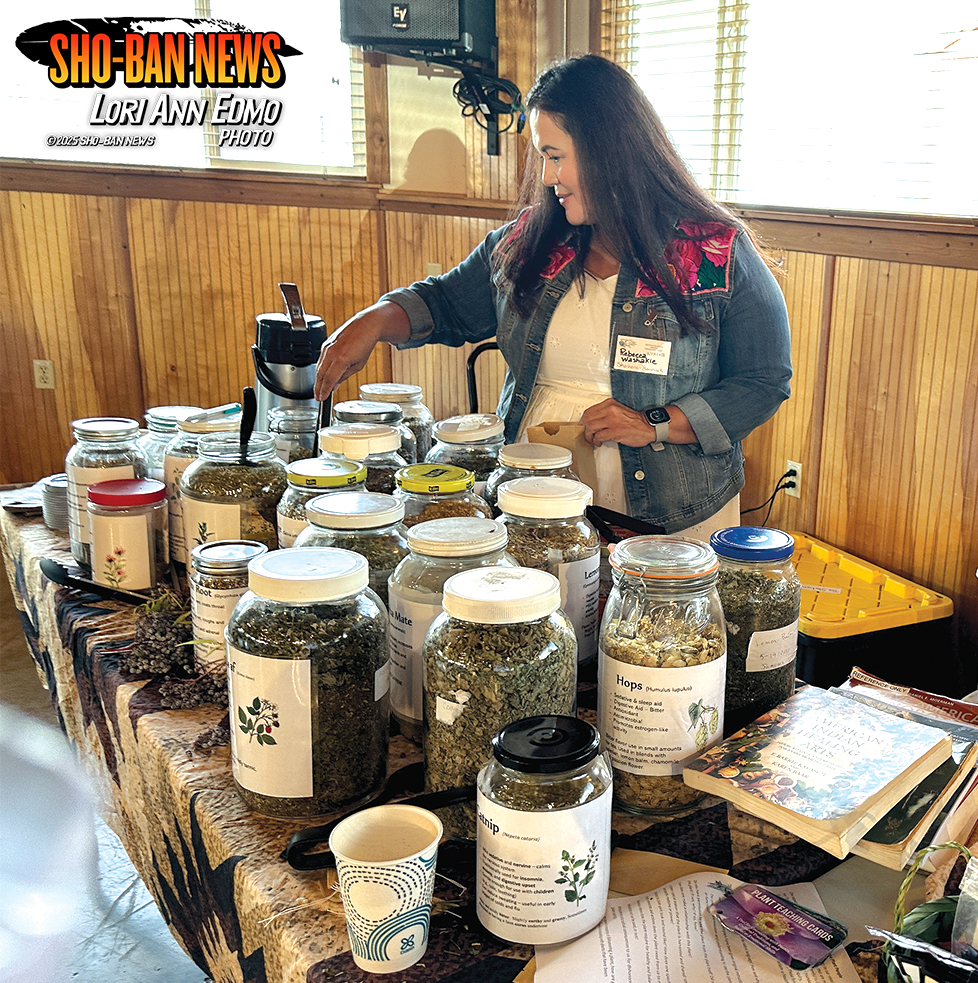
Shoshone-Bannock tribal member Rebecca Washakie, NWPAIHB Environmental Public Health
coordinator, collects an assortment of traditional herbs.
By LORI ANN EDMO
Sho-Ban News
CASCADE LOCKS, Ore. — Practicing food sovereignty was prevalent throughout the Northwest Tribal Food Sovereignty Coalition gathering September 8 and 9 in Cascade Locks along the Columbia River.
Salmon, roots, wild game, corn, traditional medicines, herbs, teas, among other food sources were available, along with food preservation.
Shoshoni Wildbill, Klamath, Northwest Portland Area Indian Health Board (NWPAIHB) Food Sovereignty Initiatives Project manager, said the coalition was created in 2017 and the gathering has been conducted ever since, even during COVID when it was done virtually. She said the coalition is not just tribal people, but also those living in tribal communities. Tribal food producers attend and resources to do trainings, but there’s also hands on education. Previous locations for the gathering were Grand Ronde, Coeur d’Alene, Yakama, along with the Washington coast.
Funding comes from a Centers for Disease Control (CDC) grant titled the Good Health and Wellness in Indian Country and they sub award to different tribes as the NWPAIHB serves tribes in Idaho, Oregon and Washington. Wildbill said they were able to fund five different tribes for their food sovereignty work such as community gardens, getting fresh produce to tribal members through food distributions or other programs.
Wildbill said she’s not sure what the future holds because their funding ends at the end of September and it’s a five-year grant, but they haven’t received their continuation funds. Although food sovereignty is a priority for health board, without the funding, she’s not sure they would be able to have the gathering in the same way. “It’s just unknown,” she said.
However, food sovereignty is very important to her, she said and the work they do is everything. “For me, food sovereignty is how we identify as people and it makes the distinction between the different tribes on what we have, what we ate and who we are.”
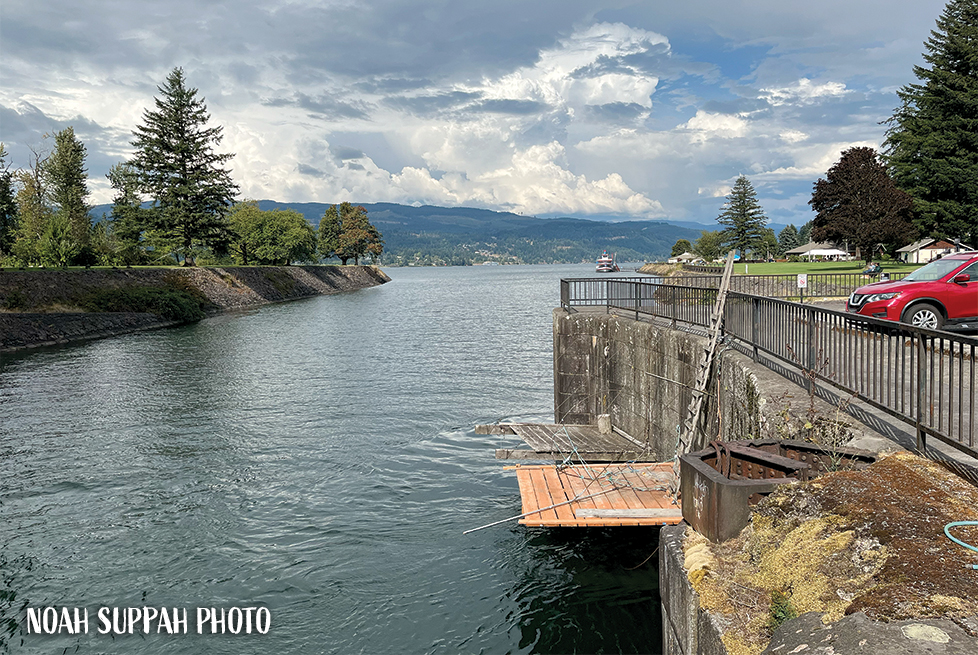
Scaffolds used for traditional food gathering are shown on the Columbia River.
Rebecca Washakie, Shoshone-Bannock, is a NWPAIHB Environmental Public Health coordinator, a position she’s worked in for almost three years since retiring from the Shoshone-Bannock Tribes. She works with food sovereignty, food safety, CPR, first aid, injury prevention, natural resource programs and projects. She works remotely from home but also travels when necessary to work with the 43 tribes in Washington, Oregon and Idaho.
On day one, workshops were offered about making huckleberry and chokecherry jam, a session on breast feeding, about food science. The second day Greg Archuleta talked about traditional foods of the Grand Ronde including Wapato or water potatoes. Wenix Red Elk, Confederated Tribes of Umatilla talked about first foods, land access and outreach, Klamath River Youth spoke on paddling tribal waters, among others.
The morning session on day two Wilbur Slockish and David Sohappy, Warm Springs and Yakama, talked about the traditional salmon fishery and how it’s impacted by industrialism, first canneries – the non-Indians would overfish then blame the tribal people for over harvest. Then the barges being used for transport and the non-Indians put in the dams flooding the traditional fishing area Celilo all for corporate profit.
Slockish explained how the tribal people took care of the water, land and air. The role of salmon, not only does it feed them, they feed the forest, the land, the animals. “That’s why these lands were rich in nutrients because when they come back from the ocean and then they spawned, the streams had a feast. And all of the other animals at the headwaters of these old streams that were in our area. That’s why the rich forest was a lot of good green grass, a lot of stuff in the timber, because the salmon not only had the role, they had the role for the entire, but now I guess what you call it, the ecosystem.”
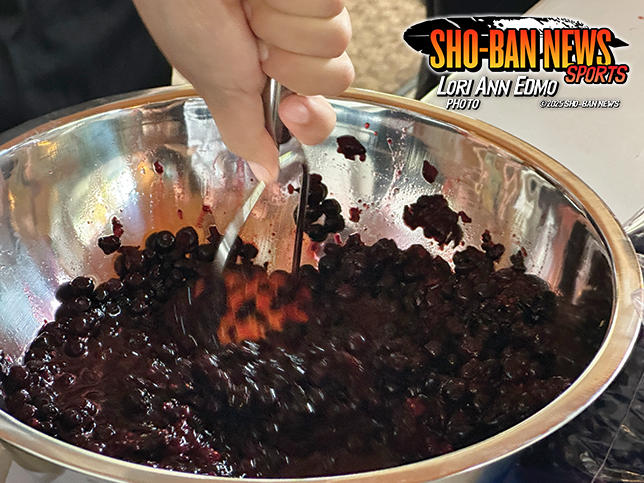
Smashing huckleberries for jam.
Each meal served during the gathering featured salmon, tribal foods, vegetables and on the second day deer meat for supper with salmon Lucy Racehorse Suppah prepared. The first evening meal was by Brigham Fish that included baked salmon. Monday evening Ed Edmo Jr., Shoshone-Bannock, did storytelling about Creation and the big river.
Wenix Red Elk, Confederated Tribes of Umatilla Natural Resources Department Public Education Outreach specialist, had an information booth where she displayed first foods and education about her tribe. For the last 17 years she’s educated on behalf of her tribe’s first foods and in 2006, the Umatilla Tribe adopted their first foods mission statement by resolution to protect and restore the tribes first foods which is first Chush, which is water, Nusukh which is salmon, Yamash which is deer, the Looksh - biscuit root, the winwinu, the huckleberry for the perpetual cultural and sovereign economics of the tribe.
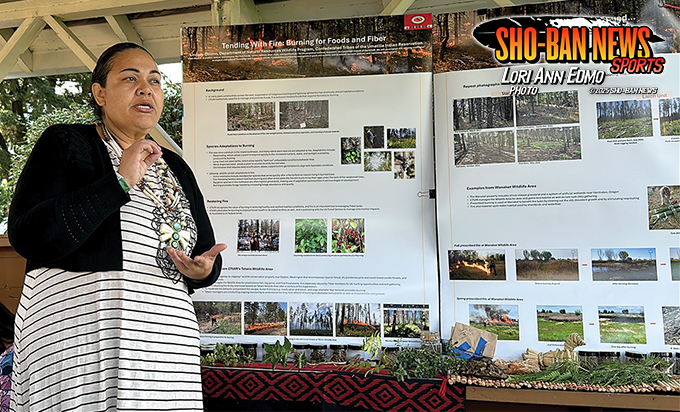
Umatilla Natural Resources Dept. Public Outreach specialist Wenix Red Elk presents on first foods.
“We do this by utilizing traditional ecological knowledge of our people first and then science to inform two different things - we look at the population habitat management goals of the tribe, looking at the populations of the animal, not only from current but from historical standpoints of what those populations and the resources related to the culture and the cultural practices across the landscape and then taking those populations and creating policies and regulatory mechanisms to be able manage and restore those foods back to the landscape as they were naturally, we want them to be to historical levels that is the first goal but we take the knowledge of our people that is what they know of what the resources were and how we want them to be in relationship to our cultural practices and our sovereign rights so the department natural resources use those as the goals and then put the science on top of that and utilize science to help us achieve those goals of the traditional knowledge first and utilizing that as our first guiding stance to move forward for those first foods,” she said.
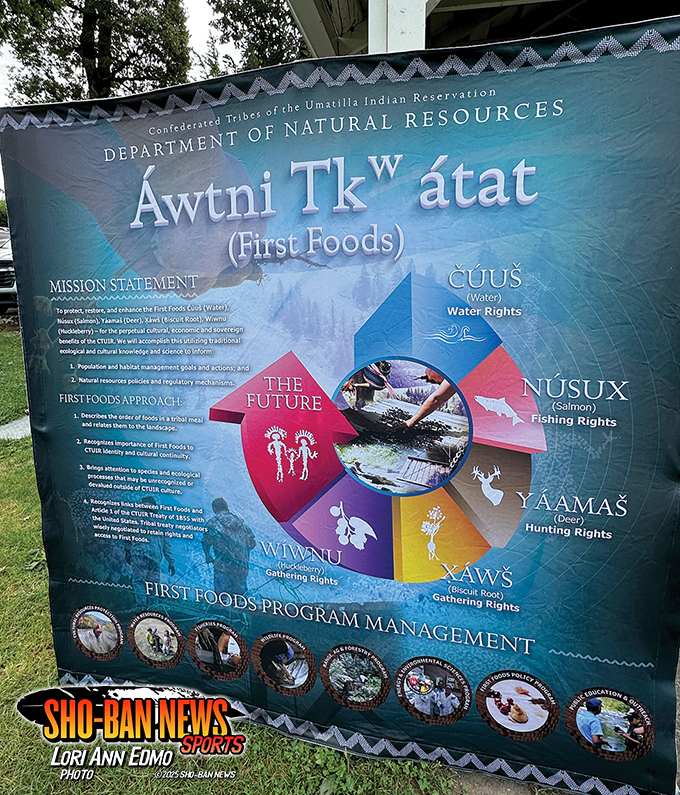
Confederated Tribes of the Umatilla Indian Reservation’s Dept. of Natural
Resources sign for “First Foods.”
Red Elk continued, “And due to our treaties, the treaties help secure the water rights, the fishing rights, the hunting rights, wildlife rights related to all those resources. The water represents everything related to the water and we have our water resources, fisheries and our wildlife that works on restoring the habitat related to that resource and then also how the correlation is to our first foods, our fisheries program works on restoring everything related to the aquatics from the keystone species of the fish all the way down to the microorganisms and the habitat related to that. Wildlife takes care of all the animal species related to all the way from the deer to the elk to the buffalo all the way down to the winged animals and the habitat related to that. Our forest agricultural range program works on protecting all the root resources related all root bearing plants and then the shrubs related from the huckleberry is representing the small shrubs making sure that those resources are sustainable on the landscape. And then we have our cultural resource protection that protects anything under the ground and above the ground and how it relates to those First Foods resources.”
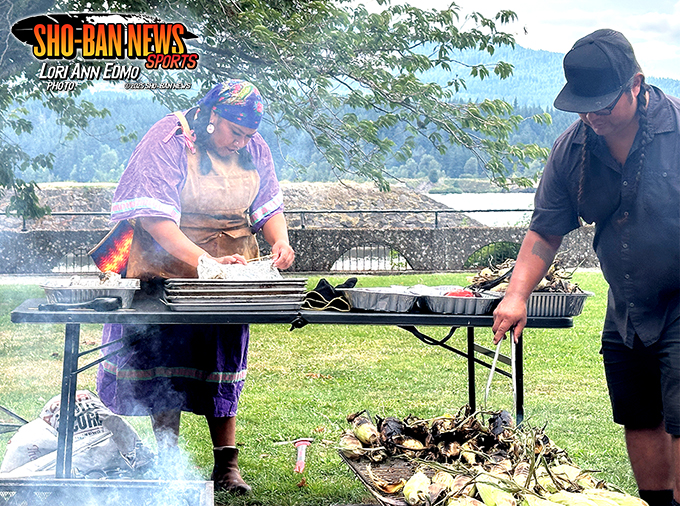
Lucy Racehorse Suppah prepares the salmon and Lukas Angus prepares corn and deer meat.
She said her job is to go out and speak on behalf of the Umatilla Tribe and the first food resources, how they’re managing it in a reciprocal way of restoring foods back to the landscape and then also helping put those foods back on the landscape so they can go out and gather and harvest in a traditional manner not in a manner related to what you would practice in school or books or in theory. But where they’re able to take out groups of people on cultural excursions where she, her co-worker and others go out to the landscape. They work with department of either forestry or with each department related to like where certain species might be.
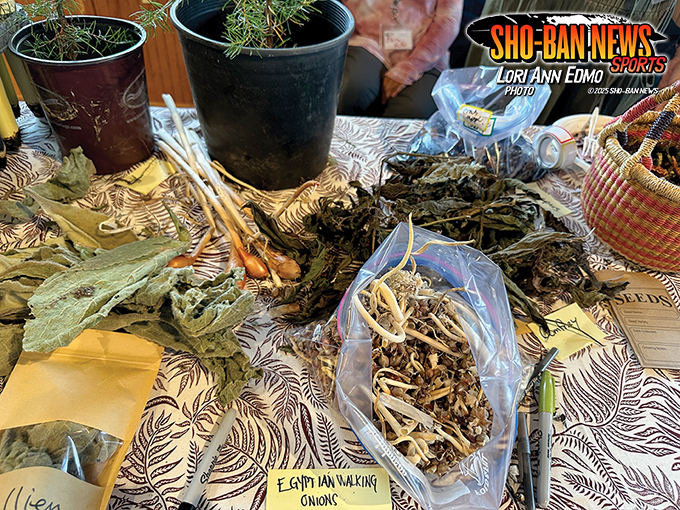
Traditional plants highlighted at the gathering.





